Jews in the revolutionary movement
Many Jews were prominent in Russian revolutionary parties. The idea of overthrowing the Tsarist regime was attractive to many members of
the Jewish-intelligentsia because of the oppression of non-Russian nations and non-Orthodox Christians within the Russian Empire. For much the same reason, many non-Russians, notably
Latvians or
Poles, were disproportionately represented in the party leaderships.
In 1897
General Jewish Labour Bund (
The Bund), was formed. Many Jews joined the ranks of two principal revolutionary parties:
Socialist-Revolutionary Party and
Russian Social Democratic Labour Party—both
Bolshevik and
Menshevik factions. A notable number of
Bolshevik party members were
ethnically Jewish, especially in the leadership of
the party, and the percentage of Jewish party members among the rival
Mensheviks was even higher. Both the founders and leaders of
Menshevik faction,
Julius Martov and
Pavel Axelrod were Jewish.
 Julius Martov
Julius Martov Pavel Axelrod
Pavel AxelrodBecause some of the leading
Bolsheviks were ethnic Jews, and
Bolshevism supports a policy of promoting international proletarian revolution—most notably in the case of
Leon Trotsky—many enemies of
Bolshevism, as well as contemporary anti-semites, draw a picture of Communism as a political slur at Jews and
accuse Jews of pursuing Bolshevism to benefit Jewish interests, reflected in the terms "
Jewish Bolshevism" or "
Judeo-Bolshevism". The original atheistic and internationalistic ideology of the Bolsheviks (See proletarian internationalism, bourgeois nationalism) was incompatible with
Jewish traditionalism. Bolsheviks such as
Trotsky echoed sentiments which dismissed Jewish heritage, in place of "
internationalism."
 Leon Trotsky
Leon TrotskySoon after seizing power, the Bolsheviks established the
Yevsektsiya,
the Jewish section of the Communist party in order to destroy the rival
Bund and Zionist parties,
suppress Judaism and replace traditional Jewish culture with "
proletarian culture".
About 450,000 Jewish soldiers served in the Russian army during the World War I, and fought side by side with their Christian fellows. When hundreds of thousands of refugees from
Poland and
Lithuania, and among them innumerable Jews, fled in terror before enemy invasion and spread over interior of Russia, Pale of Settlement de facto ceased to exist. Most of the education restrictions on the Jews were removed with appointment of count
Pavel Ignatiev as minister of education.
 2nd Congress of Soviets of the Nothern region presidium. In the front row: Moisei Uritsky, Leon Trotsky, Yakov Sverdlov, Grigory Zinoviev, Mikhail Lashevich. 1918.
2nd Congress of Soviets of the Nothern region presidium. In the front row: Moisei Uritsky, Leon Trotsky, Yakov Sverdlov, Grigory Zinoviev, Mikhail Lashevich. 1918.In March 1919,
Vladimir Lenin delivered a speech "
On Anti-Jewish Pogroms" on a gramophone disc. Lenin sought to explain the phenomenon of antisemitism in Marxist terms. According to Lenin, antisemitism was an "
attempt to divert the hatred of the workers and peasants from the exploiters toward the Jews." Linking antisemitism to class struggle, he argued that it was merely a political technique used by
the tsar to exploit religious fanaticism, popularize the despotic, unpopular regime, and divert popular anger toward a scapegoat.
The Soviet Union also officially maintained this Marxist-Leninist interpretation under
Joseph Stalin, who expounded
Lenin's critique of antisemitism. However, this did not prevent the widely publicized
repressions of Jewish intellectuals during 1948–1953 (see After World War II) when
Stalin increasingly associated
Jews with "
cosmopolitanism" and
pro-Americanism.
 Vladimir Lenin
Vladimir LeninSuch actions, along with extensive Jewish participation among the Bolsheviks, plagued the Communists during the Russian
Civil War against
the Whites with a reputation of being "
a gang of marauding Jews"; Jews comprised a majority in
the Communist Central Committee, outnumbering even
ethnic Russians. At the same time, the vast majority of Russia's Jews, much like their non-Jewish Russian neighbors, were not in any political party.
Jews were prominent in the Russian
Constitutional Democrat Party,
Russian Social Democratic Party (
Mensheviks) and
Socialist-Revolutionary Party. The Russian Anarchist movement also included many prominent Jewish revolutionaries. In
Ukraine,
Makhnovist anarchist leaders also included several Jews.
The attempts of
the socialist Bund to be the sole representative of the Jewish worker in Russia had always conflicted with Lenin's idea of a universal coalition of workers of all nationalities. Like some other socialist parties in Russia,
the Bund was initially opposed to the Bolsheviks' seizing of power in 1917 and to the dissolution of the Russian Constituent Assembly. Consequently,
the Bund suffered repressions in the first months of
the Soviet regime. However,
the antisemitism of many Whites during the Russian Civil War caused many if not most Bund members to readily join the Bolsheviks, and most of the factions eventually
merged with the Communist Party. The movement did split in three;
the Bundist identity survived in interwar Poland, while many
Bundists joined
the Mensheviks.
 Members of the Socialist Bund march in a May Day parade. Bialystok, Poland, May 1 1934
Members of the Socialist Bund march in a May Day parade. Bialystok, Poland, May 1 1934In August 1919 Jewish properties, including synagogues, were seized and many Jewish communities were dissolved. The anti-religious laws against all expressions of religion and religious education were being taken out on the Jewish population, just like on other religious groups. Many Rabbis and other religious officials were forced to resign from their posts under the threat of violent persecution. This type of persecution continued on into the 1920s.
In 1921, a large number of Jews opted for Poland, as they were entitled by peace treaty in Riga to choose the country they preferred. Several hundred thousand joined the already numerous Jewish population of Poland.The chaotic years of World War I, the
February and
October Revolutions, and the Civil War were fertile ground for the antisemitism that was endemic to tsarist Russia. During the World War, Jews were often accused of sympathizing with Germany and often persecuted.
Pogroms were unleashed throughout the Russian Civil War, perpetrated by virtually every competing faction, from Polish and Ukrainian nationalists to the Red and White Armies.
31,071 civilian Jews were killed during documented pogroms throughout the former Russian Empire; the number of Jewish orphans exceeded 300,000. Majority of pogroms in Ukraine during 1918–1920 were perpetrated by the Ukrainian nationalists, miscellaneous bands and anti-Communist forces.
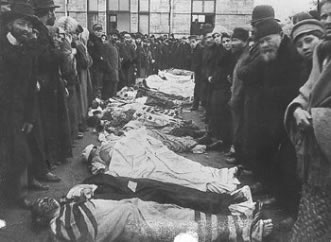 During 1919, when the Ukrainians have to retreat, anti-Jewish violence on an unprecedented scale claims tens of thousands of lives. None of the perpetrators is prosecuted. The majority of Jews in the Ukraine, fearful of Ukrainian independence, come to regard the Red Army more and more as the only force capable to stop the violence.
During 1919, when the Ukrainians have to retreat, anti-Jewish violence on an unprecedented scale claims tens of thousands of lives. None of the perpetrators is prosecuted. The majority of Jews in the Ukraine, fearful of Ukrainian independence, come to regard the Red Army more and more as the only force capable to stop the violence. 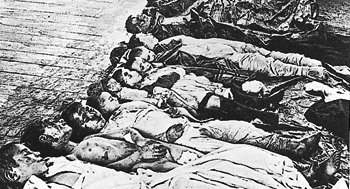 Jewish children killed in a 1905 pogrom in Yekaterinoslav (now Dnipropetrovsk, Ukraine)
Jewish children killed in a 1905 pogrom in Yekaterinoslav (now Dnipropetrovsk, Ukraine)Continuing the policy of the Bolsheviks before the Revolution, Lenin and the Bolshevik Party strongly condemned the pogroms, including official denunciations in 1918 by the Council of People's Commissars.
Opposition to the pogroms and to manifestations of Russian antisemitism in this era were complicated by both the official Bolshevik policy of assimilationism towards all national and religious minorities, and concerns about overemphasizing Jewish concerns for fear of exacerbating popular antisemitism, as the White forces were openly identifying the Bolshevik regime with Jews.
Lenin was intrigued with technology and in 1919 recorded eight of his speeches on gramophone records. Only seven of these were later re-recorded and put on sale. The one suppressed in the
Nikita Khrushchev era recorded Lenin's feelings on antisemitism.:
“
The Tsarist police, in alliance with the landowners and the capitalists, organized pogroms against the Jews. The landowners and capitalists tried to divert the hatred of the workers and peasants who were tortured by want against the Jews. ... Only the most ignorant and downtrodden people can believe the lies and slander that are spread about the Jews. ... It is not the Jews who are the enemies of the working people. The enemies of the workers are the capitalists of all countries. Among the Jews there are working people, and they form the majority. They are our brothers, who, like us, are oppressed by capital; they are our comrades in the struggle for socialism. Among the Jews there are kulaks, exploiters and capitalists, just as there are among the Russians, and among people of all nations... Rich Jews, like rich Russians, and the rich in all countries, are in alliance to oppress, crush, rob and disunite the workers... Shame on accursed Tsarism which tortured and persecuted the Jews. Shame on those who foment hatred towards the Jews, who foment hatred towards other nations. ”
Lenin was supported by
the Labor Zionist (
Poale Zion) movement, then under the leadership of Marxist theorist
Ber Borochov, which was fighting for the creation of
a Jewish workers' state in Palestine and also participated in
the October Revolution (and in the Soviet political scene afterwards until being banned by
Stalin in
1928). While
Lenin remained opposed to outward forms of
antisemitism (and all forms of
racism), allowing Jewish people to rise to the highest offices in both party and state, certain historians such as
Dmitri Volkogonov argue that the record of his government in this regard was highly uneven. A former official Soviet historian (turned staunch anti-communist),
Volkogonov claims that
Lenin was aware of
pogroms carried out by units of
the Red Army during the war with
Poland, particularly those carried out by
Semyon Budyonny's troops, though the whole issue was effectively ignored.
Volkogonov writes that "
While condemning anti-Semitism in general, Lenin was unable to analyze, let alone eradicate, its prevalence in Soviet society". Likewise, the hostility of the Soviet regime towards all religion made no exception for
Judaism, and the 1921 campaign against religion saw the seizure of many synagogues (whether this should be regarded as
antisemitism is a matter of definition – since Orthodox churches received the same treatment).
Yet, according to Jewish historian
Zvi Gitelman: "
Never before in Russian history—and never subsequently has a government made such an effort to uproot and stamp out antisemitism".
 Jewish historian Zvi Gitelman
Jewish historian Zvi GitelmanAt the same time, the economic position of the Jewish population in USSR was not good. Soviet laws offered hardly any economic independence to artisans, and none whatever to traders. For many Jewish artisans and tradesmen, Soviet policies led to loss of their property and trade. On the other hand, thousands of Jewish semi-intellectuals and social failures have tested unlimited, uncensored power by joining the communist party and soviet bureaucracy.
According to the census of 1926, total number of Jews in USSR was 2,672,398 – of whom 59% lived in Ukrainian SSR, 15,2% in Byelorussian SSR, 22% in Russian SFSR and 3,8% in other Soviet republics.
Soviet Union before World War IIRussian Jews were long considered a non-native Semitic ethnicity within
a Slavic Russia, and such categorization was solidified when ethnic minorities in the Soviet Union were categorized according to ethnicity (национальность). In his 1913 theoretical work Marxism and the National Question
Stalin described Jews as "
not a living and active nation, but something mystical, intangible and supernatural. For, I repeat, what sort of nation, for instance, is a Jewish nation which consists of Georgian, Daghestanian, Russian, American and other Jews, the members of which do not understand each other (since they speak different languages), inhabit different parts of the globe, will never see each other, and will never act together, whether in time of peace or in time of war?!" According to
Stalin, who became
the People's Commissar for Nationalities Affairs after the revolution, to qualify as a nation, a minority was required to have a culture, a language, and a homeland.
 Jozef Stalin
Jozef StalinTo offset the growing Jewish national and religious aspirations of Zionism and to successfully categorize Soviet Jews under Stalin's definition of nationality, an alternative to
the Land of Israel was established with the help of Komzet and OZET in 1928. The Jewish Autonomous Oblast with the center in
Birobidzhan in the Russian Far East was to become a "
Soviet Zion".
The Soviet authorities considered the use of
Hebrew language "
reactionary" since it was associated with both
Judaism and
Zionism, and the teaching of
Hebrew at primary and secondary schools was officially banned by the
Narkompros (
Commissariat of Education) as early as 1919, as part of an overall agenda aiming to secularize education. Hebrew books and periodicals ceased to be published and were seized from the libraries, although liturgical texts were still published until the 1930s. Despite numerous protests in the West, teachers and students who attempted to study the Hebrew language were pilloried and sentenced for "
counter revolutionary" and later for "
anti-Soviet" activities.
Yiddish, rather than
Hebrew, would be the national language, and proletarian socialist literature and arts would replace
Judaism as the quintessence of culture. Despite a massive domestic and international state propaganda campaign, the Jewish population in
the Jewish Autonomous Oblast never reached 30% (as of 2003 it was only about 1.2%). The experiment ground to a halt in the mid-1930s, during
Stalin's first campaign of purges. Jewish leaders were arrested and executed, and
Yiddish schools were shut down.
In his January 12, 1931 letter "
Antisemitism: Reply to an Inquiry of the Jewish News Agency in the United States"
Stalin officially condemned antisemitism:
"
In answer to your inquiry: National and racial chauvinism is a vestige of the misanthropic customs characteristic of the period of cannibalism. Antisemitism, as an extreme form of racial chauvinism, is the most dangerous vestige of cannibalism. Antisemitism is of advantage to the exploiters as a lightning conductor that deflects the blows aimed by the working people at capitalism. Antisemitism is dangerous for the working people as being a false path that leads them off the right road and lands them in the jungle. Hence Communists, as consistent internationalists, cannot but be irreconcilable, sworn enemies of antisemitism. In the U.S.S.R. antisemitism is punishable with the utmost severity of the law as a phenomenon deeply hostile to the Soviet system. Under U.S.S.R. law active antisemites are liable to the death penalty. "
In 1936
Pravda, the party's newspaper and main propaganda organ, printed a beneficial explanation of the vile nature of antisemitism. It stated that "national and racial chauvinism is a survival of the barbarous practices of the cannibalistic period... it served the exploiters... to protect capitalism from the attack of the working class; antisemitism, a phenomenon profoundly hostile to the Soviet Union, is repressed in the USSR."
The Molotov-Ribbentrop pact—the 1939 non-aggression pact with Nazi Germany—created further suspicion regarding
the Soviet Union's position toward
Jews. According to the pact
Poland, the nation with
the world's largest Jewish population, was divided between
Germany and
the Soviet Union in
September 1939. While the pact had no basis in ideological sympathy (as evidenced by Nazi propaganda about "
Jewish Bolshevism"), Germany's occupation of
Western Poland was a disaster for
Central European Jews. Evidence suggests that some, at least, of the Jews in
the Eastern Soviet zone of occupation welcomed
the Russians as having a more liberated policy towards their civil rights than
the preceding antisemitic Polish regime. Jews in areas annexed by the
Soviet Union were
deported Eastward in great waves; as these areas would soon be invaded by
Nazi Germany, this forced migration, deplored by many of its victims, paradoxically also saved the lives of
a few hundred thousand Jewish deportees.
Many Jews fell victim to
The Great Purges, although there is no evidence that Jews were specifically targeted by
Stalin. A number of the most prominent victims of
the Purges—
Trotsky,
Zinoviev, and
Kamenev, to name a few—
were ethnic Jews, but Stalin was just as brutal when acting against his real or imagined enemies who were not Jewish—e.g.,
Bukharin,
Tukhachevsky,
Kirov, and
Ordzhonikidze.
 Grigory Yevseevich Zinoviev, before his execution in August 25, 1936
Grigory Yevseevich Zinoviev, before his execution in August 25, 1936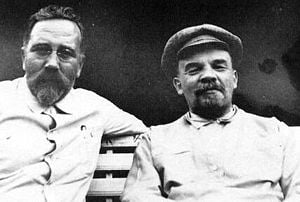 Kamenev and Lenin at Gorki Leninskiye, 1922
Kamenev and Lenin at Gorki Leninskiye, 1922Jews who escaped the purges include
Lazar Kaganovich, who came to
Stalin's attention in the 1920s as a successful bureaucrat in
Tashkent and participated in the purges of the 1930s.
Kaganovich's loyalty endured even after
Stalin's death, when he and
Molotov were expelled from the party ranks in 1957 due to their
opposition to destalinization.
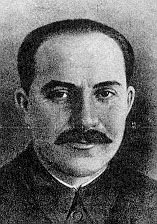 Lazar Kaganovich, responsibility for 1932-33 famine, the Holodomor
Lazar Kaganovich, responsibility for 1932-33 famine, the HolodomorBeyond longstanding controversies, ranging from
the Molotov-Ribbentrop Pact to anti-Zionism, the Soviet Union did grant official "
equality of all citizens regardless of status, sex, race, religion, and nationality." The years before
the Holocaust were an era of rapid change for
Soviet Jews, leaving behind the dreadful poverty of the Pale of Settlement. Forty percent of the population in the former Pale left for large cities within the USSR.
Emphasis on education and movement from countryside shtetls to newly industrialized cities allowed many Soviet Jews to enjoy overall advances under Stalin and to become one of the most educated population groups in the world.
Because of Stalinist emphasis on its urban population,
interwar migration inadvertently rescued countless Soviet Jews; Nazi Germany penetrated the entire former Jewish Pale—but were kilometers short of Leningrad and Moscow. The migration of many Jews farther East from the Jewish Pale, which would become occupied by Nazi Germany, saved at least
40 percent of the Pale's original Jewish population.
The HolocaustOver two million Soviet Jews are believed to have died during the Holocaust,
second only to the number of Polish Jews to have fallen victims to Hitler. Among some of the larger massacres in
1941 were:
33,771 Jews of
Kiev shot in ditches at
Babi Yar;
100,000 Jews and
Poles of
Vilnius killed in the forests of
Ponary,
20,000 Jews killed in Kharkiv at Drobnitzky Yar,
36,000 Jews machine-gunned in
Odessa,
25,000 Jews of
Riga killed in the woods at
Rumbula, and
10,000 Jews slaughtered in
Simferopol in the
Crimea. Though mass shootings continued through 1942, most notably
16,000 Jews shot at
Pinsk, Jews were increasingly shipped to concentration camps in German Nazi-occupied
Poland.
Local residents of German-occupied areas, especially
Ukrainians,
Lithuanians, and
Latvians, sometimes
played key roles in
the genocide of
other Latvians, Lithuanians, Ukrainians, Slavs, Gypsies, homosexuals and Jews alike. Under the Nazi occupation, some members of
the Ukrainian and
Latvian Nazi police carried out deportations in
the Warsaw Ghetto, and
Lithuanians marched Jews to their death at Ponary. Even as some assisted the Germans,
a significant number of individuals in the territories under German control also helped Jews escape death (
see Righteous Among the Nations).
In Latvia, particularly, the number of Nazi-collaborators was only slightly more than that of Jewish saviours.
It is estimated that up to 1.4 million Jews fought in Allied armies; 40% of them in the Red Army. In total, at least 142 500 Soviet soldiers of Jewish nationality lost their lives fighting against the German invaders and their allies.
The official response to an inquiry by JAC about the military decorations of Jews during the war (1.8% of the total number). Some antisemites attempted to accuse Jews of lack of patriotism and of hiding from military service.
The typical Soviet policy regarding the Holocaust was to present it as atrocities against Soviet citizens,
not emphasizing the genocide of the Jews. For example, after the liberation of
Kiev from the Nazi occupation, the Extraordinary State Commission (Чрезвычайная Государственная Комиссия) was set out to investigate Nazi crimes. The description of the Babi Yar massacre was officially censored as follows:
Stalinist antisemitic campaignsIn January 1948
Solomon Mikhoels, a popular actor-director of the Moscow State Jewish Theater and the chairman of the Jewish Anti-Fascist Committee, was killed in a suspicious car accident. Mass arrests of prominent Jewish intellectuals and suppression of Jewish culture followed under the banners of campaign against "
rootless cosmopolitans" and
anti-Zionism. On August 12,
1952, in the event known as
the Night of the Murdered Poets, thirteen of the most prominent
Yiddish writers, poets, actors and other intellectuals were executed on the orders of
Joseph Stalin, among them
Peretz Markish,
Leib Kvitko,
David Hofstein,
Itzik Feffer and
David Bergelson. In the 1955 UN Assembly's session a high Soviet official still denied the "
rumors" about their disappearance.
 Poet Peretz Markish
Poet Peretz Markish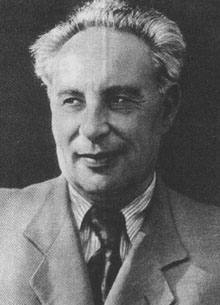 Poet Leib Kvitko
Poet Leib Kvitko Poet David Hofstein
Poet David Hofstein Poet Itzik Feffer
Poet Itzik Feffer Poet David BergelsonThe Doctors' plot
Poet David BergelsonThe Doctors' plot allegation in
1953 was a deliberately antisemitic policy:
Stalin targeted "
corrupt Jewish bourgeois nationalists," eschewing the usual code words like "
rootless cosmopolitans" or "
cosmopolitans." Stalin died, however, before this next wave of arrests and executions could be launched in earnest. A number of historians claim that the Doctors' plot was intended as the opening of a campaign that would have resulted in the mass deportation of Soviet Jews had Stalin not died on March 5, 1953. Days after Stalin's death the plot was declared a hoax by the Soviet government.
These cases may have reflected Stalin's paranoia, rather than state ideology—a distinction that made no practical difference as long as Stalin was alive, but which became salient on his death.
In April 1956, the Warsaw Yiddish language Jewish newspaper
Folkshtimme published sensational long
lists of Soviet Jews who had perished before and after the Holocaust. The world press began demanding answers from Soviet leaders, as well as inquire about current condition of Jewish education system and culture. The same autumn, a group of leading Jewish world figures publicly requested the heads of Soviet state to clarify the situation. Since no cohesive answer was received, their concern was only heightened.
The fate of Soviet Jews emerged as a major human rights issue in the West.









